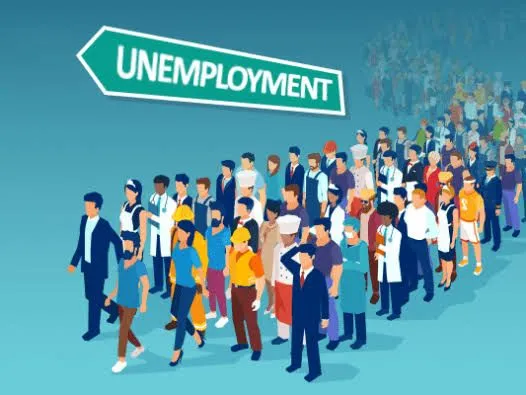Unemployment in India: The Struggles and Mental Health Crisis Among Youth

India, with its vast population and dynamic economy, stands at a crossroads where the dreams of its youth often collide with the harsh reality of unemployment. As of September 2024, the unemployment rate in India stands at 7.8%, a slight decline from 8.5% in August, according to the Centre for Monitoring Indian Economy (CMIE). However, for the youth—those aged 15–29—the situation is far more alarming, with unemployment rates reaching as high as 29.9% in states like Kerala, particularly among educated young women (47.1%) . This blog delves into the unemployment crisis in India, the struggles faced by young people, and the mental health challenges, particularly depression, that arise from it.
The Unemployment Crisis: A Growing Concern
India’s youth unemployment is a structural issue, rooted in a mismatch between the skills of the workforce and the demands of the job market. Despite economic growth rates of 8.4% in Q4 2023, the economy struggles to create enough quality jobs, particularly in non-agricultural sectors . The Periodic Labour Force Survey (PLFS) 2023-24 highlights that 83% of the unemployed workforce in India consists of youth, with the share of those with secondary or higher education nearly doubling from 35.2% in 2000 to 65.7% in 2022 .
Several factors contribute to this crisis:
-
- Skill Gaps: A NASSCOM report estimates that 80% of India’s 1.5 million annual engineering graduates lack employable skills, and by 2026, India may face a shortage of 1.4–1.9 million tech professionals .
-
- Economic Structure: The service sector, while driving growth, is less labor-intensive than manufacturing, which employs only 13% of the workforce compared to the government’s target of 25% .
-
- Overpopulation: With a rapidly growing population, job creation cannot keep pace, exacerbating unemployment, particularly in rural areas where seasonal agricultural work dominates .
-
- COVID-19 Aftermath: The pandemic caused a spike in unemployment, peaking at 27.11% in May 2020, with 140 million jobs lost during the lockdown .
These statistics paint a grim picture, but the human toll is even more profound.
The Struggles of India’s Youth
For India’s youth, unemployment is not just a lack of income—it’s a loss of identity, purpose, and hope. Graduates flood the job market each year, only to face fierce competition and limited opportunities. In 2022, riots erupted in Bihar and Uttar Pradesh over alleged irregularities in railway recruitment, a stark reminder of the desperation among young job seekers .
Many young people, particularly in urban areas, apply for jobs far below their qualifications, leading to underemployment. For instance, highly educated youth often refuse low-paying or low-status jobs, while illiterate youth are more likely to accept any work, resulting in lower unemployment rates among the latter . Women face additional barriers, with only 25% participating in the labor force, often due to social norms and lack of childcare infrastructure .
The Not in Education, Employment, or Training (NEET) category is particularly alarming, with 34.5% of youth idling in 2018–19, engaging in what sociologist Craig Jeffrey calls “timepass”—a state of aimlessness that erodes motivation . This lack of engagement can have long-term “scarring effects,” increasing the likelihood of future unemployment and lower wages.
The Mental Health Crisis: Depression and Anxiety
Unemployment takes a severe toll on mental health, particularly among educated youth. A 2024 study in Kolkata found that 54.4% of unemployed migrant graduate youth aged 21–35 experienced depression, 61.8% faced anxiety, and 47.9% reported stress, significantly higher than their employed counterparts . The pressure to secure a stable job, coupled with societal expectations, creates a vicious cycle of frustration and despair.
“I don’t want people to be sad for me, I feel sad for myself enough. I just want people to understand,” said a young woman anonymously in a 2019 India Today Conclave film on teenage depression .
Depression among youth is exacerbated by social factors like loneliness, academic pressure, and the fear of missing out, amplified by social media . The COVID-19 pandemic worsened these challenges, disrupting routines and social connections, leading to increased mental health issues . A 2017 Hindustan Times study noted that 65% of Indian youngsters showed early signs of depression, with poor financial stability as a major trigger .
For many, the stigma around mental health in India prevents seeking help. Only 40% of youth believe it’s acceptable to seek support for mental health issues, leaving many to suffer in silence .
Pathways Forward
Addressing India’s unemployment and mental health crisis requires a multi-pronged approach:
-
- Skill Development: Align education with industry needs through vocational training and apprenticeships. Programs like the National Skill Development Corporation aim to skill 29.82 crore workers, but implementation must improve .
-
- Job Creation: Invest in labor-intensive sectors like manufacturing and infrastructure. The government’s Production-Linked Incentive (PLI) scheme, allocating US$25 billion, is a step forward but must prioritize job creation .
-
- Mental Health Support: Increase access to mental health services and reduce stigma through awareness campaigns. Schools and colleges should integrate counseling services to support students .
-
- Policy Reforms: Streamline labor laws and encourage private sector participation to create sustainable jobs, particularly for women and rural youth .
India’s youth are its greatest asset, but without action, the demographic dividend risks becoming a demographic disaster. By addressing unemployment and mental health, we can empower young Indians to build a brighter future.
Conclusion
The unemployment crisis in India is more than an economic challenge—it’s a human one. The struggles of jobless youth, compounded by depression and anxiety, demand urgent attention. As I reflect on my own journey, having completed a digital marketing course and earned my certificate, I recognize the importance of resilience and opportunity. Let’s advocate for policies that create jobs, bridge skill gaps, and prioritize mental health, ensuring that India’s youth can thrive, not just survive.

